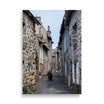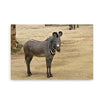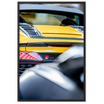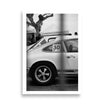Street Photography: Capturing the Essence of Urban Life
Introduction
Street photography is a fascinating art form that captures the essence of urban life. By capturing spontaneous moments on the streets, street photographers tell stories, reveal emotions, and document everyday reality. The discipline requires a keen eye, great sensitivity, and an ability to anticipate the decisive moment. This article explores the techniques, challenges, and tips for excelling in street photography.
What is Street Photography?
Street photography is a branch of documentary photography that focuses on capturing unposed images of everyday life in public spaces. Unlike other photographic genres, it does not require staging, models, or sophisticated lighting. The goal is to capture authentic moments and reveal the beauty and complexity of urban life.
History of Street Photography
1. The Pioneers
The roots of street photography date back to the 19th century with photographers like Eugène Atget, who documented the streets of Paris. Later, iconic figures like Henri Cartier-Bresson and Robert Frank helped popularize the genre with their iconic images and approach to the "decisive moment."
2. Evolution and Influence
Street photography has evolved over the decades, influenced by social, cultural, and technological changes. Today, it continues to thrive thanks to digital cameras and smartphones, making the art form more accessible than ever.
Essential Techniques in Street Photography
1. Observation and Anticipation
The key to street photography is careful observation and anticipation of interesting moments. Photographers must be constantly on the lookout for captivating scenes and be ready to capture the moment.
2. Composition
Good composition is crucial. Use techniques like the rule of thirds, leading lines, and natural framing to create balanced and aesthetically pleasing images.
3. Use of Light
Light plays a vital role in street photography. Take advantage of natural light, shadows and reflections to add depth and dimension to your images.
4. Discretion and Respect
Be discreet so as not to disturb the scene you want to capture. Use short focal lengths to stay at a distance and always respect the privacy of the people being photographed.
5. Light Equipment
Opt for lightweight and portable equipment. A compact camera or smartphone allows you to move around easily and be responsive.
Street Photography Challenges
1. Respect for Privacy
Street photography often involves photographing strangers. It is important to respect their privacy and not be intrusive. If someone refuses to be photographed, respect their request.
2. Weather Conditions
Weather conditions can be unpredictable. Be prepared for rain, wind, or snow, and use these conditions to your advantage to capture unique images.
3. Security
Stay aware of your surroundings to avoid potentially dangerous situations. Always keep your equipment secure and be vigilant in high crime areas.
Tips for Success in Street Photography
1. Practice Regularly
As with any skill, regular practice is essential. Get out with your camera often and take pictures whenever you get the chance.
2. Study the Masters
Explore the work of great street photographers like Henri Cartier-Bresson, Vivian Maier, and Garry Winogrand. Learn from their techniques and be inspired by their works.
3. Develop your Personal Style
Experiment with different approaches and techniques to develop your own style. Whether you prefer black and white or color images, close-ups or wide shots, find what works best for you.
4. Participate in Communities
Join online or local street photography communities. Share your photos, get constructive feedback, and learn from others.
5. Telling Stories
Aim to tell stories through your images. Capture scenes that evoke emotions, human relationships, or particular aspects of urban life.
Recommended Equipment for Street Photography
1. Compact Cameras
Compact and mirrorless cameras are great for street photography because they are lightweight and discreet. Models like the Fujifilm X100V or Sony RX100 are great choices.
2. Fixed Focal Length Lenses
Prime lenses, such as 35mm or 50mm, are ideal for their wide aperture and image quality. They also force photographers to move around to frame their subjects, which can improve composition.
3. Useful Accessories
A lightweight backpack, extra memory cards, spare batteries and a lens cleaning cloth are essential accessories for a day of shooting in the city.
Inspiring Examples of Street Photography
1. Henri Cartier-Bresson
Considered the father of street photography, Henri Cartier-Bresson captured decisive moments with unparalleled precision. His black and white images are perfect examples of composition and timing.
2. Vivian Maier
Vivian Maier, a nanny and amateur photographer, left behind thousands of fascinating street photographs. Her work, discovered after her death, offers a unique perspective on American urban life in the mid-20th century.
3. Garry Winogrand
Garry Winogrand is known for his dynamic and spontaneous images of urban life. His bold approach and use of the camera as an extension of his vision make him an iconic figure in street photography.
Conclusion
Street photography is an exciting art form that captures the essence of urban life. By mastering essential techniques, overcoming challenges, and developing a personal style, you can create images that tell stories and evoke emotions. Whether you’re a beginner or an experienced photographer, the streets offer an endless source of inspiration and moments to capture.
FAQs
What is street photography? Street photography is a branch of documentary photography that captures unposed images of everyday life in public spaces, highlighting authentic and spontaneous moments.
What equipment is recommended for street photography? Compact cameras, prime lenses like 35mm or 50mm, and accessories like extra memory cards and spare batteries are recommended for street photography.
How can I improve my street photography skills? To improve your skills, practice regularly, study the work of great street photographers, develop your own style, participate in photography communities, and seek to tell stories through your images.
What are common challenges in street photography? Common challenges include privacy of the people being photographed, unpredictable weather conditions, and safety in urban areas.
How to choose the right camera for street photography? Choose a lightweight, portable camera with good image quality and easy-to-use controls. Compact and mirrorless cameras are often the best choices for their discretion and performance.




































































Leave a comment
All comments are moderated before being published.
This site is protected by hCaptcha and the hCaptcha Privacy Policy and Terms of Service apply.